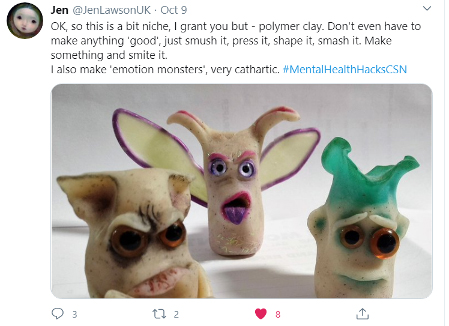Mental Health Hacks Explained: Making your symptoms ‘tangible’
Brain Yapping by Dr Dean BurnettAs part of World Mental Health Day 2020, Dean Burnett and Cosmic Shambles asked people to submit their ‘Mental Health Hacks’, the tricks, techniques and approaches they’ve worked out, that help them deal with when their rebellious mind turns against them.
The best 5 Mental Health Hacks win a copy of Dean’s Audiobook Psycho-Logical, all about what’s going on in the brain when we experience mental health problems, and will have a Cosmic Shambles post dedicated to explaining how and why they could work, in the neurological sense. This is one of those posts.

Jen Lawson on Twitter uses a particular substance to deal with her mental health issues. I don’t mean a narcotic, or even a prescribed drug like antidepressants. No, it’s clay.
She either smashes or squashes the short-lived forms she makes, or creates wonderful little ‘emotion monsters’ that she keeps. This is an intriguing, and revealing, method of staving off the effects of a mental health problem, and they tell us something very interesting about how the brain works here.

Some hardcore rationalists reading this may scoff, or worry that I’ve gone soft (like clay) by endorsing something like this, but I would advise you to hold off on the scorn for the moment. Because there are numerous reasons that this approach could be genuinely helpful. Primarily, it helps make a mental health problem more tangible.
One of the main problems with mental disorders, one which I’d argue underlies a great deal of stigma, suspicion, misunderstanding, and fear around them, is that they are, as hinted at, intangible. Their causes, and often even their symptoms, are confusing, mysterious, and very hard to pin down. There’s no anxiety germ to tackle with antibiotics, no schizophrenia boil that can be lanced.
When the health problem is mental, meaning the issue is with your mind (something science cannot yet see, measure or assess) or emotions (which still have yet to be thoroughly defined by science), it becomes a lot more confusing. You usually cannot trace the issue to one specific cause or source, you don’t know exactly what’s going wrong in your mind and brain to produce the symptoms you’re experiencing, and it’s considerably harder to separate yourself from your problem.
If you break your leg, it sucks. But you aren’t your leg. Nor are you your tumour, or your infection. But while valid to do so, it’s a lot harder to separate your own identity from your problem when it occurs within your own mind. It’s far more insidious, more nebulous, and there’s a lot less certainty.
And that’s a key factor. Uncertainty. Uncertainty, in its various guises, is a major cause of stress for the human brain. And stress is an underlying cause in many mental health conditions. It’s often the case that mental health problems are caused by stress, and then cause more stress, and become ever stronger and self-sustaining due to this vicious cycle.
The uncertainty and poor understanding of mental health problems means they often deprive people of a sense of control. A loss of any sense of control is another thing that leads to more stress and worse mental health. This is another reason why telling someone with depression to ‘cheer up’, or someone with anxiety to ‘chill out’ is massively unhelpful. As well as being dismissive and ignorant (even if well meant), it’s not like the individuals have this option. If they could choose to not feel like they do, they obviously would. But they can’t. It’s beyond their control. Insisting otherwise just emphasises this unhelpful fact.
But… what if your mental health problem did have a tangible source? One you could define, manipulate, and control? Wouldn’t that help matters?

Yes. And that’s what a number of therapies are based on. There’s biofeedback, or neurofeedback, where individuals are connected to monitors that display things like their heart rate, muscle tone, and other physiological activity in their body (neurofeedback does the same, but with brainwaves and the like). The objective is for them to actively change the levels seen on the monitors, when experiencing symptoms of their condition.
We do this sort of thing all the time, like if we’re startled, we make an effort to calm ourselves down. But bio/neurofeedback makes this easier again, and it’s particularly useful for mental health problems, and even things like migraines, or ADHD.
If you tell someone ‘stop being anxious’, they can’t. They don’t know why they’re anxious, they don’t know, and can’t tell, where the anxiety begins and ends. It’s an impossible task. But if you instead tell them “Here’s your heart rate on this monitor, try to lower it”, this is a much easier task. Your brain can see the heart rate, has a target to aim for, can recognise if what it’s doing has the desired effect, and so on. And given how increased heart rate is a typical symptom of anxiety, by tackling it you are technically working on limiting your anxiety.
More recent developments have become even more complex and intriguing. Avatar therapy is a newer approach whereby software is used to create virtual avatar of, for instance, the auditory hallucinations experienced by someone with schizophrenia. Rather than a voice in their head, it becomes a voice on the screen. It gives the symptom a source, one that the afflicted brain can comprehend, understand, and engage with directly.
A different type of Avatar therapy and one that may in fact make your mental health far worse.
Granted, the software avatar isn’t the source of the hallucinations. Not really. But if the brain thinks it is, even slightly, it helps. And why wouldn’t it? All of what we perceive as reality is generated by our brain at some point, so why shouldn’t it accept that a software figure is the cause of a mental symptom?
And if you accept this as viable, it doesn’t necessarily need to be a high-tech medically administered intervention. Perhaps you can achieve the same result with some clay. Or words on a page. Or any type of creation.
Perhaps this helps explain why so many famous artists struggled with mental health problems, and mental health is regularly linked to creativity. Because mental health is so uncertain and hard to control, things our brains really don’t like. But by expressing your problems as tangible, real-world things, you potentially give them form, and boundaries, and allow interaction, and therefore control. You effectively ‘anchor’ them in terms of how they’re perceived in the brain. You go from “I don’t know what this is” to “This is that thing, now”. And that can be a big help for many.
So many people still say that mental health problems are ‘all in your head’. This is a meaningless statement; everything we encounter and experience is all in your head, because that’s how the brain works.
But approaches like Jen’s help coax mental health problems out of our head, where our brain’s can comprehend and deal with them better.
Dean Burnett’s book Psycho-Logical is available from Audible. A print version is due in Feb 2021, via Faber.
 Dr Dean Burnett is a neuroscientist and best selling author of such books as The Idiot Brain and The Happy Brain. His former column Brain Flapping for The Guardian (now Brain Yapping here on the CSN) was the most popular blog on their platform with millions of readers worldwide. He is a former tutor and lecturer for the Cardiff University Centre for Medical Education and is currently an honorary research associate at Cardiff Psychology School and Visiting Industry Fellow at Birmingham City University. He is @garwboy on Twitter.
Dr Dean Burnett is a neuroscientist and best selling author of such books as The Idiot Brain and The Happy Brain. His former column Brain Flapping for The Guardian (now Brain Yapping here on the CSN) was the most popular blog on their platform with millions of readers worldwide. He is a former tutor and lecturer for the Cardiff University Centre for Medical Education and is currently an honorary research associate at Cardiff Psychology School and Visiting Industry Fellow at Birmingham City University. He is @garwboy on Twitter.
If you would like to reuse this content please contact us for details
Subscribe to The Cosmic Shambles Network Mailing list here.

